Exposition au musée
From April 12th to August 21st, 2022

Main picture modal

Aristide Maillol (1861-1944). The Quest for Harmony
Back
Maillol the Painter
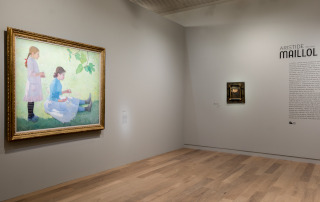
Maillol arrived in Paris in 1882 to pursue his vocation as a painter. He studied at Alexandre Cabanel’s studio and then with Jean-Paul Laurens. In 1885, he was admitted to the École des Beaux-Arts.
His first known work, a Self-Portrait dated 1884, reveals his debt to Courbet. He subsequently painted mainly landscapes bathed in the sunlight of his native Roussillon, to which he returned on a regular basis. After discovering Puvis de Chavannes in 1887, then Gauguin in 1889, he adopted a radically different approach, as can be seen in The Crown of Flowers (1889), a synthetist painting featuring areas of flat colour, a rejection of linear perspective, and experiments with decorative effects. In around 1890, Maillol’s painting career took on a fresh lease of life with commissions from the Roussillon sculptor Gabriel Faraill. He painted his daughters in profile, often wearing extravagant hats, in head and shoulder poses, and occasionally full length, as he was keen on large formats. These portraits reflected his trips to museums, where he studied portraits from the early Renaissance (Pisanello) as keenly as those by his contemporaries, such as Whistler’s Portrait of the Artist’s Mother (1871).
Questions de décor
Exploring Decor

Like many of his contemporaries, Maillol was interested in materials, “for no reason other than pleasure”, according to his biographer Judith Cladel. This curiosity led him to explore other disciplines in the 1890s, beginning with embroidery. He presented his first embroidery at the Salon of the Société nationale des beaux-arts in 1893. Concert of Women caught the eye of the Nabi artists in 1895. Édouard Vuillard introduced Maillol to Princess Hélène Bibesco, his first patron, who encouraged him to pursue this path. He produced embroideries, wall hangings, seat covers, and fire screens.
While watching his needlewomen making embroideries, Maillol carved his first wooden pieces and soon turned his hand to ceramics in Banyuls and Paris. Since he lacked specialist equipment, he produced simply- made everyday objects; he exhibited vases and nightlights in 1897, followed by a relief, and finally indoor fountains, one of which won a silver medal at the Universal Exhibition of 1900.
In 1899, he was admitted to the Société nationale des beaux-arts in the ‘Objets d’art’ section, but the enjoyment he derived from carving wood and modelling statuettes prompted him to turn towards sculpture instead.
Bathers and Washer Women
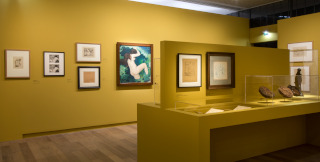
In around 1895, Maillol became interested in the themes of washerwomen and bathers. He was probably influenced by the art of Paul Gauguin which he discovered in 1889 through their mutual friend, the painter George-Daniel de Monfreid. Gauguin’s taste for experimenting and the extraordinary ease with which he moved from one discipline to another and could recycle and adapt his motifs according to his materials and supports, revealed a potential new way forward for Maillol. His art between 1895 and 1904 was characterised by the simultaneous practice of painting, embroidery, printmaking and sculpture, until he developed eye problems and sculpture came to the fore.
His first accomplished nude, The Wave, was probably painted from memory without a model. The body of a decorative bather in muted tones, silhouetted against the sea, fills the entire frame. The bather was transposed to a print and then became Maillol’s most Gauguinesque wood engraving, against a backdrop of water dotted with large dark areas of movement. Maillol also transcribed this design into a relief medallion: the emphasis is on the solidity of the curved body in contrast to the rippling wave (on the table in the centre of this section).
His exploration of bathers both in rear view and from the front became a long-term pursuit, particularly in his illustrations for Virgil’s Eclogues.
Towards Sculpture
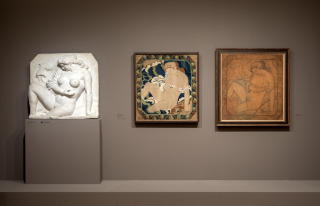
In 1896, Maillol exhibited a painting entitled On the Seabed at the Le Barc de Boutteville gallery (Paris). It may have been Woman with a Wave which he believed to be one of his finest paintings. His model was his partner Clotilde, who was soon to become his wife.
He produced a less tightly-framed working-scale drawing in charcoal as a reference cartoon for Clotilde to create an embroidered fire screen.
Maillol adopted a deliberately decorative and anatomically impossible composition, framed by a foliage frieze.
He developed this motif in a variety of ways on different supports: wood engravings, and eventually a large-scale relief in plaster which was presented in a prominent position at the Salon de la Société nationale des beaux-arts in 1903 through the intervention of Rodin.
In this relief entitled Woman Bathing, the reference to the sea has almost disappeared. A flimsy floating drapery covers the right arm and discreetly brings to life the background from which a simplified powerful and monumental body emerges.
This plaster is the first surviving large-format sculpture by Maillol prior to Mediterranean.
The Bathers Period
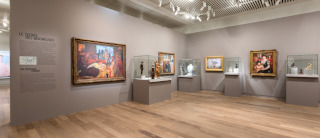
Maillol’s friend, the Hungarian painter József Rippl-Rónai, introduced him to the Nabis in 1893. In May 1902, his Leda figure was presented at the Galerie Bernheim-Jeune (Paris) among paintings by Bonnard, Denis, Roussel, Vuillard, and Vallotton. A year later, Maillol moved from Villeneuve to Marly-le-Roi to be closer to his friends, especially Maurice Denis, who lived in Saint-Germain-en-Laye.
Probably through Édouard Vuillard, Maillol met the art dealer Ambroise Vollard, who encouraged him to pursue his sculpture. In 1902, Vollard organised his first solo exhibition and they signed a contract to produce editions of his statuettes.
Although he continued to carve wood, Maillol now modelled timeless bathers with great economy, with simplified contours and minimalist movements. In a seminal text, Maurice Denis praises Maillol’s soberness, balanced proportions and instinctive awkwardness. According to Octave Mirbeau, “What I admire in Maillol, […] is the purity, clarity, and limpidity of his craft and thinking; in none of his works, or at least none that I have seen, is there ever anything to attract the curiosity of a passer-by!”
Maillol and Germany
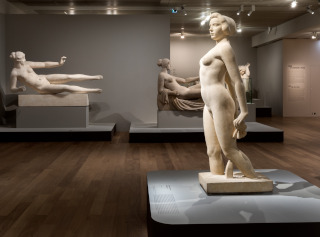
Harry Kessler, Ambroise Vollard, Maurice Denis, and Henry Van de Velde were responsible for raising Maillol’s profile abroad. An admirer of Maillol’s sculptures before he even met him in 1904, Kessler worked to promote Maillol in his homeland. Maillol claimed in 1905: “Since I have made your acquaintance, I feel great warmth from Germany”. In 1906, the music room belonging to theatre director Kurt von Mutzenbecher in Wiesbaden, and Kessler’s apartment in Weimar were decorated by Maurice Denis and Maillol, with Henry Van de Velde overseeing the work. In 1914, Kessler sent a telegram to Maillol advising him to bury his statues as German forces were advancing. Maillol was accused of complicity with the enemy, but was cleared with backing from Georges Clemenceau.
During World War II, his Germanophile sympathies led Maillol to play host to German soldiers in Banyuls. Although he refused the trip to Germany organised for French artists by the Nazi occupiers, he did however attend the inauguration of the exhibition devoted to the Third Reich sculptor Arno Breker in Paris in 1942, taking advantage of this opportunity to cross the demarcation line into occupied territory and visit his studio in Marly.
This regrettable episode did lasting damage to his reputation.
Maillol the Catalan

Maillol was born and raised in Banyuls-sur-Mer (Pyrénées-Orientales), and spent his winters there. The painters George-Daniel de Monfreid and Étienne Terrus, and later the sculptor Manolo Hugué, formed part of his intimate group of friends. He had close ties with the circle of writers and musicians in Perpignan who championed Catalan culture. For his Parisian friends, he was inseparable from the Roussillon, embodied by the generous Pomone. Rippl-Rónai depicts his friend in front of the tiled roofs of Banyuls. Bonnard, Vuillard and the Bibesco brothers, Maurice Denis, Kessler and many others visited him there.
In Banyuls, Maillol lived in the Maison rose, which had belonged to his grandfather, in the heart of the coastal village. In 1894, he set up an embroiderers’ workshop and produced his first sculptures there. He drew the women and young girls around him going about their everyday lives. In 1912, he acquired a farm house inland in the Roume valley. He was at one with nature there and this was expressed in his illustrations for works by Virgil and Horace. It was entirely fitting that Jean Lods’ should go to Banyuls to shoot footage of the man Maurice Denis described as “Virgil’s goatherd, in love with all the nature of his little homeland”.
Clotilde the Model Wife

Maillol’s relationship with Clotilde Narcis, whom he quickly married, allowed him to have a model permanently to hand: “I lift up my wife’s skirts and see a block of marble.” Clotilde corresponded to an ideal Mediterranean type. Maillol liked dense bodies, strong legs and well- developed curves: “Sculpture is a masculine art, it must be strong, otherwise it is nothing.”
Maillol drew Clotilde continuously for some twelve years from 1895 until at least 1907. She posed for his early monumental sculptures: Mediterranean, Night, and Action in Chains. He drew her in her private life in quick sketches capturing a line or posture.
Maillol did not draw in order to record the true nature of a moment but “to understand [the] body” of his models. He was motivated by an aspiration to generalise and simplify, and to show common anatomical and structural principles. Although the models are recognisable in a certain number of drawings, Maillol cultivated distance vis-à-vis his sittings: “I look at the model, and when my eye has absorbed it fully, I work on paper to draw what I have understood. I don’t check whether the model and the drawing are exactly the same, you see, I don’t copy the model.”
From one Model to Another
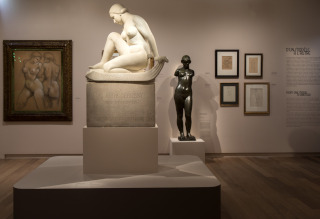
Over the years, Clotilde posed less frequently. Around 1900, Maillol approached other models: the first torso for Youth was modelled between 1905 and 1910 from a “splendid young girl, who would come and pose for me. She had a very unusual body”.
Maillol was also accustomed to asking his servants to sit for him, which was a discreet and easy option: Laure for Pomone, Thérèse in the post- war period. During the creative process, Maillol created a synthesis, often based on several models. For Île-de-France, he began in 1910 with a supple, rangy model, followed by “la môme Papa” in the early 1920s, then a third model, a black domestic servant working for the Hahnloser family.
In 1907, Maillol confided to Harry Kessler: “Once I get started, I will only do men, it’s much easier. With a man there is always something, a muscle, to fix on. With women, there is nothing, no shapes, you have to invent it all, unless they are very well developed, but that’s rare”.
Encouraged by Kessler, he had several male models pose for him, notably the young Gaston Colin, for Desire and The Cyclist. In 1911, Kessler put Maillol forward for a project for a Monument to Nietzsche in Weimar, an Apollo figure based on the Russian dancer Vaslav Nijinsky, whose poses he simplified. This abortive experiment marked the end of Maillol’s male sculptures, although he continued to draw men on a regular basis in his sketchbooks and illustrations.
Dina, the Last Muse
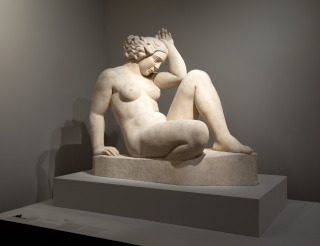
Maillol’s meeting with the young Dina Aïbinder seemed to be the fulfilment of a prophecy dating back to 1907: “When I find the model who suits me perfectly, I will spend four or five years working on making a statue of her. That’s how you create beautiful things, that’s what the Greeks did”. The architect Jean-Claude Dondel mentioned the young fifteen year-old girl to Maillol, prompting him to write to her: “I would like you to be a little Maillol, which is quite difficult to find. But I would settle for a little Renoir!” Dina inspired some of Maillol’s paintings and posed for The Mountain, The River, and at intervals in Banyuls between 1940 and 1944 for his last great work, Harmony. After the young woman’s arrest for crossing the Franco- Spanish border, the sculptor sent her to pose for his friends Henri Matisse and Pierre Bonnard in early 1941. Dina was arrested again in May 1943.
Maillol secured her release, and she resumed sitting for him. Like a father, Maillol feared for the life of this model who had become a key part of his own life: “Dina is like a daughter to me. I am happy to have been able to save her.” When the young woman left to take part in the Liberation of Paris, Maillol was more isolated the ever. He died on 27 September 1944 from injuries sustained in a car accident, far from the woman who had promised to be with him at the very end. She made the elevation of Maillol her life’s work.